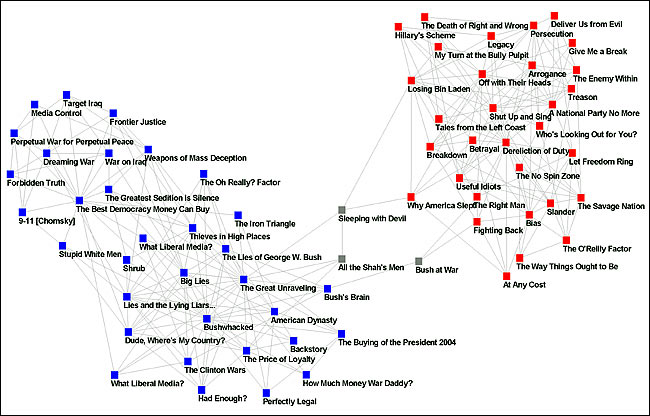Across the great divide
 I first pointed to this stunning Valdis Krebs infographic back in March 2004, when the New York Times published it. Krebs has long been fascinated with the clusters that emerge from an analysis of Amazon's related-purchase data. I was reminded of his chart the other day when I heard this exchange (Real, 1 min, 40 sec) between Terri Gross and Norman Podhoretz, which includes this quote:
I first pointed to this stunning Valdis Krebs infographic back in March 2004, when the New York Times published it. Krebs has long been fascinated with the clusters that emerge from an analysis of Amazon's related-purchase data. I was reminded of his chart the other day when I heard this exchange (Real, 1 min, 40 sec) between Terri Gross and Norman Podhoretz, which includes this quote:
I have almost no friends any longer who are liberal, and I suspect this is true of most people on both sides of the divide. Since the sixties, the polarization has become more intense, and there are fewer and fewer friendships that can be sustained across the divide in this country.
What religious differences used to be, and aren't any more (in our world, not the Muslim world), political differences have become. They've acquired a kind of religious intensity, and are tinged with a kind of intolerance that used to characterize religious differences. [Norman Podhoretz, inteviewed by Terri Gross on NPR's Fresh Air, Real, 20 min.]
Having lived on both sides of the chasm -- he was a radical liberal before he became a founder of neoconservativism -- Podhoretz seems to have a rare appreciation of the great divide. I suspect the majority of us, not having lived on both sides, lack that same gut-level appreciation.
In the same way that Valdis' chart highlights books that bridge the divide, there must be people who do. Towards the end of the interview, Terri Gross asks:
So, do you think James Carville and Mary Matalin should be giving us all lessons in how to get along?
Great question!
Krebs, as I mentioned in the InfoWorld cover story on social software, has used social network analysis to help untangle dysfunctional corporations. I wonder if such methods could be helpful to societies too?
Update: Valdis Krebs recently published a new version of his political-book map.
Former URL: http://weblog.infoworld.com/udell/2004/09/04.html#a1068
 I first pointed to this stunning Valdis Krebs infographic back in March 2004, when the New York Times published it. Krebs has long been fascinated with the clusters that emerge from an analysis of Amazon's related-purchase data. I was reminded of his chart the other day when I heard this exchange (Real, 1 min, 40 sec) between Terri Gross and Norman Podhoretz, which includes this quote:
I first pointed to this stunning Valdis Krebs infographic back in March 2004, when the New York Times published it. Krebs has long been fascinated with the clusters that emerge from an analysis of Amazon's related-purchase data. I was reminded of his chart the other day when I heard this exchange (Real, 1 min, 40 sec) between Terri Gross and Norman Podhoretz, which includes this quote: